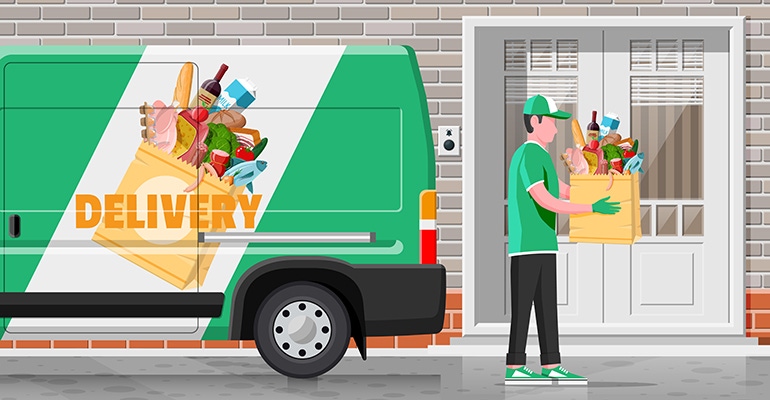November 10, 2021

The COVID-19 pandemic has changed how Americans shop for food. Though e-commerce grocery had been growing slowly for years, the onset of the crisis in early 2020 kicked this trend into overdrive. To minimize their risk of exposure to the deadly virus, even faithful in-store shoppers began buying food online—and many haven't stopped. According to a Coresight Research survey published in May, nearly 60% of Americans now purchase groceries online, and roughly the same percentage plans to do so indefinitely.
This new landscape has prompted natural products retailers nationwide to launch or expand online ordering and delivery services, hoping to recapture lost sales and attract new customers. Some have found success with their programs and now want to scale up; others have struggled to make delivery work. Other retailers would like to launch delivery but just aren't sure how to go about it. Here is some expert advice for independents looking to implement or grow a delivery service—and actually make money at it.
Retail management consultant

L.E.K. Consulting in Boston, Massachusetts
Assess need. Evaluate how much convenience it will offer, which depends on several factors. First, location: In urban centers, where people have to walk or take public transportation, delivery sales are more incremental, so it works well more frequently. If you're in an easy-drivability, well-trafficked area and your sales are solid, delivery likely won't add much incremental value. It also depends on store size. For example, both CVS and Walmart launched delivery. CVS saw almost no adoption because the service just didn't solve a customer need. Walmart saw massive growth because, as everyone knows, it's painful to get in and out of there.
Analyze margins, not total sales. With independents, I recommend cautiously testing delivery. But you must track and analyze what's happening rigorously to understand what the trial is showing you. Oftentimes, independents just see that their total sales are up and determine delivery is working. That doesn't provide an accurate picture, though. You need to treat delivery like a different channel: "This is what moved, this was the cost to move it, this was the cost of goods and commission—OK, that's my real margin." Then compare that to where in-store sales are trending. You hope both are increasing at the same time and that, over time, delivery customers are converting to in-store customers or increasing their basket sizes.
Track who is ordering online. Many independents don't invest in customer-level tracking, which makes it hard to disentangle whether they are getting incremental value from delivery. You need to be sure that you're not cannibalizing quality store trips with low-quality shops and that you're attracting shoppers who wouldn't otherwise come into the store. Keep an eye on your customer file to know who is ordering online and whether each order is displacing a store trip. If you're merely turning in-store customers into delivery customers and not making more money, is it really worth it?
Retailer

Roots Market in Clarksville and Olney, Maryland
Be realistic about capacity. We had started working on delivery and planned to roll it out by May 2020, but when the pandemic hit in March, we had to just go for it. It was trial by fire, and we learned a ton. We frantically started off doing an exorbitant number of orders thinking we could handle it. But we didn't fully know the process yet, and we put people in those roles who were new to the company, which was challenging. We learned we just hadn't been reasonable with our expectations. So, the biggest thing is to be realistic about your expectations and what you want to accomplish. To make sure your quality stays up to par, set parameters around lead times, know what your team is capable of and keep delivery at a manageable level for pickers and guests.
Charge a fee. When we started off, we did not have a service fee. We did that purposely because we didn't want to charge people for using a program that would keep them safe from COVID-19. But after things calmed down with the pandemic, we added a service fee to offset the costs. I get why retailers would rather not charge, but long-term, it's tough to cover the labor, platform fees, packaging materials, extra bags and other odds and ends without a fee. A standard 10% upcharge should cover the extra labor of picking. And for most third-party services, delivery fees are around $10, which is more or less a picker's fee.
Maintain exceptional customer service. We pride ourselves on our customer service, so we try to carry that through so guests feel like they're in-store and not on a computer. This means making sure our website is up to date on how many items we offer, what's in stock and what might be available only in-store. Also, knowing it may be difficult for some customers to navigate the website, we allow them to place orders over the phone. Another personalized thing we've done is call guests when we've been out of something to discuss other options. We also aim to answer all customer questions quickly and correctly because we want people to feel comfortable staying home and having us pick their groceries.
Grocery digital strategist

Brick Meets Click in Barrington, Illinois
Choose markup over margin share. Some third-party delivery groups take margin share. If your margin is 40%, they may ask for 10% of that to defray the cost of delivery. You have to be careful about this, or these groups could destroy your model. Other delivery entities mark up the prices of products instead, usually around 15% for big grocery, so conceivably 18% or 20% for natural products independents. This model typically works better because customers appreciate the additional service and understand that items will cost more than in-store, so they are not as price sensitive. If you have a choice, choose markups, but experiment with what is acceptable to customers.
Look beyond the big guys. Many retailers have only heard of Instacart, Shipt and the other big players. These operators are powerful, and they'll try to take your margin, data and relationship with customers. True, you'll probably lose something if you contract with any third party, but you don't have to lose everything. Therefore, independent retailers shouldn't just beg for a big guy to come help them—or take a third-party's services at any terms. Besides, there are a lot more delivery opportunities than you may think. Many people are putting together small, localized programs and looking for businesses to help build capacity. In today's gig economy, it could just be a guy with a truck.
Streamline deliveries. If you decide to handle delivery yourself, take control over the timing and routes to ensure efficiency and proper staffing. Think of a taxicab that responds to individual calls versus a bus that follows a predictable route and schedule. Obviously, bus transportation is substantially cheaper to run, and it requires people to know the schedule and go to the bus stop. So, instead of delivery on-demand, offer it within certain geographical areas and time windows. Then, hopefully, you'll get multiple orders coming in from the same general area at the same time. You could even announce that you'll only activate the service if enough people sign up.
About the Author(s)
You May Also Like
.png?width=700&auto=webp&quality=80&disable=upscale)




